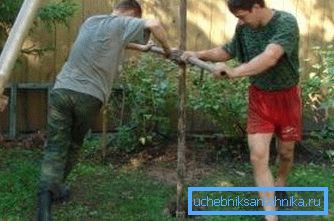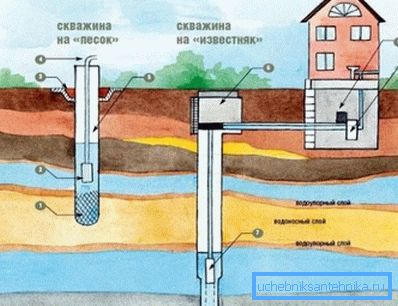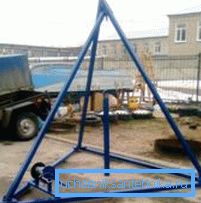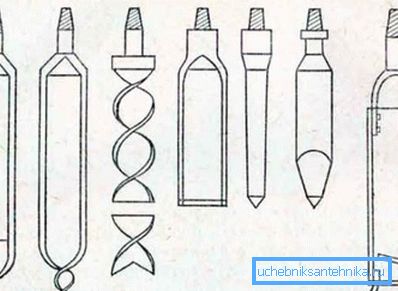How to drill a hole in soft soil
When choosing a suburban site for building a house or a dacha, you must first learn about the water on it, i.e. if the central waterway or aquifers beneath its surface. Not idle will also be the question - how much does it cost to drill a well, and how long will it take place. You must understand that without a resource like water, it is impossible to keep a household in the summer cottage.
Most often, because of the remoteness of land ownership, it is impractical to keep the central water supply system, and in this case its price will be “golden”. It is cheaper and easier to use an individual source, which must first be properly organized.

A well in a country plot will provide its owner with confidence in the continuous supply of water for household needs and for a garden or vegetable garden at any time. In addition, do not have to pay the water supply organization for each cubic meter of water.
What to do - well or well? The first few people can do, besides, it is difficult to dig, and in some cases it is simply impossible. Another thing is a well that can be drilled in any soil, and the cost will depend on its depth. There are technologies that allow you to make it yourself with one or two assistants.
Wells and their characteristics
Before you drill the well itself, examine the site and determine the level of groundwater.
This parameter will be decisive in calculating the amount of work and the choice of the type of well.
- Depth 3-12 m - “Abyssinian well”.
- Up to 50 m - sandy.
- Below 200 m - artesian.
Almost every owner can make the first two options at the dacha, the third one will require a drilling rig and professional drillers.

- Sandy hole or "on the sand." This source involves the issuance of water from a depth of up to 50 m. They call it that way because the water-containing sandy layer of the soil usually lies at this level. The depth does not guarantee the purity of the water, so it is necessary to periodically check it in the sanitary station for the presence of chemical and organic compounds. In the sandy borehole, the classical scheme with a pump is used. The cleaning of water wells from debris and suspensions produced by the filter, which is installed at a depth. It must be periodically cleaned. The life of the well - 15 years.
- Abyssinian well. The simplest option is a well-needle. Since its depth is small, you need to take care of the choice of place for it. There should not be:
- garbage heaps;
- septic tanks;
- gutters;
- cesspools
Otherwise, due to the small depth, harmful impurities can leak into the source and contaminate it.
If the ground does not have pebbles and other hard rock, a sandy hole and the “Abyssinian well” type can be drilled near the house or even in its basement. The latter will be convenient to use in the cold.
Tip: equip a home well not only with an electric pump, but also with a hand column, then the water supply will not be affected by electricity.
- Artesian well. If there are already sources of this type of water in nearby areas, there is a high probability that the level passes in a limestone formation. In other cases, it is necessary to drill an experimental well to determine its depth. An artesian well is able to provide water to several sites simultaneously. Therefore, drilling is often ordered in purse, which is more economical with the desired result. The choice of well type depends on the soil at the site and the planned water flow. Up to 10 m3 a sandy and “Abyssinian well” will come up, more than that - an artesian well.
Tip: drill any well away from possible contaminants and close to housing, then there will be no problems with the laying of water pipes.
Tools and equipment
If professional equipment is needed to drill artesian wells, for others the usual tripod with a winch is sufficient. Naturally, this does not apply to difficult soils, for example, rocky.
Simple drilling tools:
- core tube;
- drill rods;
- borax;
- drilling columns;
- auger, a tool that allows you to delve into the ground, often used ice drill;
- winch;
- tripod.
Materials for well construction and water supply:
- casing;
- hoses;
- water pipes;
- valves;
- filters;
- caisson;
- well pump.

Parched well
Sometimes there are offers from owners of private farmsteads - to make a well in a dried-up well, thinking that in this way they can save. In fact, everything happens the other way around, since the counting of the depth during drilling goes from the surface of the earth. In addition, an already dug well will present a certain difficulty for the operation of the boring machine.
If you want to get to the aquifer from a dried-up well with a manual drill, you will encounter a problem - difficulty or even unreality to break layers in front of the aquifer. What can manual drilling give? Having drilled 2-3 m, you will be able to find out if the well should be dredged further using repair rings.
Drilling
Below will be offered a short instruction that will answer almost all questions related to this process.
- Drill with a drill O 150-200 mm depth of 1 m. Then the pipe will be more stable to keep in an upright position.
- Put a solid metal tripod over the recess and secure the winch at the junction of its supports. Hang a drill column with 1.5 m long rods on a tripod. They will then need to be fixed to each other with a threaded connection and secured with a hose clamp. The design will be used for equipment descent.
- Select a pump in advance to know the diameter of the core pipe and the future well. It must pass through the pipe freely, so the difference between its diameter and the internal diameter of the pipe must be from 5 mm.
- Raising and lowering drilling equipment is called drilling. Crank the barbell, hitting it simultaneously on top. Can I do it myself? It is possible, but it is better to do this in a pair: one scrolls with a gas key, the second one hits, punching the rock. Winch simplifies the process. Mark the rods and try to clean the drill every 500 mm.
- Use special drills to overcome different layers of soil:
- clay - spiral;
- solid soil - a drill bit, which loosens it;
- sandy - with a spoon, preferably with the addition of water during operation.

To raise the soil to the surface is used scone.
- When the rock from the drill becomes wet, then the aquifer is already close. It is necessary to cross the groundwater level, while drilling will become much easier, but you can not stop. You must reach the water resistant layer.
Arrangement and buildup
- Pull down the filter column, which you can make yourself or buy in the store a ready-made anti-sand filter designed for a submersible pump.
- Hammer in space with 5 mm gravel or coarse sand to strengthen the pipe. The filter will protect from large impurities and sand.

- Simultaneously with backfilling, pump water into a pipe that has a sealed upper end to flush the filter and the annulus.
- Zonal well bore auger pump or nozzle-zhelonkoy pump out water until it becomes transparent and clean. This stage is called buildup. Most often used electric centrifugal pump.

- After pumping, lower the pump on the safety cable into the pipe and connect a hose and a water pipe O 25 mm or O 50 mm to it. The choice depends on the flow of water that can be lifted to the surface in a certain time.
When using a metal pipe, the pump does not need to be fixed. Attach instead to the pipe a waterproof cable that goes from the pump.

The advantages and disadvantages of handheld drilling
Benefits:
- low cost of work;
- does not require the use of bulky special equipment in the suburban area;
- faster pumping occurs because of the shallow depth, they are less drawn out;
- in the absence of electricity, water is delivered to the surface with a hand pump.
The disadvantage is the limited depth, there are not so many specialists who can assist in the maintenance of such a well.
Conclusion
This article was about the manual method of drilling a well in a country plot. In fact, it was described how to equip it and carry out the buildup. In the accessible words the stages of work and their features were highlighted.
You also learned about whether it is possible to drill a well in a well and whether it is worth it at all. In the presented video in this article you will find additional information on this topic.